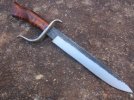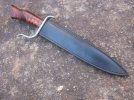G L Drew
Knifemaker / Craftsman / Service Provider
- Joined
- Feb 3, 2005
- Messages
- 4,724
I have been asked several times to make knives for the reenactment folks but I have a tough time making them "period correct" with my equipment; no antique sandstone grinding wheel, brain tanned leather or linen thread for the sheath. Some guys even want the knife to be beat up, rusted and dragged behind a horse to make it look very old. (weren't there any new knives in 1776?) Has anybody here had experience with this type of knife who could make some suggestions?
Here is a photo of a knife that was rejected by a customer because it "just looks too modern".


Here is a photo of a knife that was rejected by a customer because it "just looks too modern".




